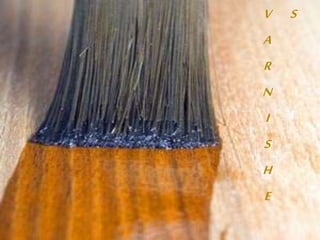
Varnishes
- 1. V A R N I S H E S
- 2. What is Varnish? Varnish is a solution of resin or resinous substances (such as common resin, amber, copal, shellac etc) in alcohol, turpentine or oil. It enhances and gives warmth to the grain of the wood and is resistant to impact, heat, abrasion, water, and alcohol. It can be used as a topcoat over worn finishes.
- 3. Why varnishing is done? To intensify or brighten the appearance of natural grains in wood. To render brilliancy to the painted surface. To protect painted surface from atmospheric action. To protect unpainted wooden surfaces of doors, windows, roof trusses, floors etc from atmospheric action.
- 4. Surface preparation Knotting Stopping Coat of Varnish The wood surface is made smooth by rubbing it using sand paper or pumice stone. It is the process of covering or killing all knots in the wood work with a substance through which the resin cannot come out or exude since the resin coming out the knots would damage the paint It is done by means of hot weak glue size so that pores on the surface are filled up. • Boiled linseed oil can be applied in 2 coats . • The dry surface should then be rubbed down with On the clean surface, two or more coats of varnish is applied. • The next coat is applied when the previous coat has dried up thoroughly. PROCESS OF VARNISHING
- 5. Characteristics of a good varnish It should dry rapidly It should form a hard film on drying. It should not crack on drying. It should have sufficient elasticity. It should be durable and weather resistant. It should give uniform and pleasing appearance. It should not hide the natural grain of the inner surface of timber. The colour of Varnish should not fade away with time.
- 6. Properties transparent hard protective finish It is combination of a drying oil, a resin, and a thinner or solvent. glossy but may be designed to produce satin or semi-gloss sheens by the addition of "flatting" agents.
- 7. Ingredients of Varnish Driers Resins or resinous substances Solvents DRIERS Driers accelerate the process of drying of a varnish. Common driers used in varnishes are litharge, white copper and lead acetate.
- 8. ALKYD- TYPE OF DRYER Typically, modern commercially produced varnishes employ some form of alkyd for producing a protective film. Alkyds are chemically modified vegetable oils which operate well in a wide range of conditions and can be engineered to speed up the cure rate and thus harden faster.
- 9. RESINS OR RESINOUS SUBSTANCES The quality of resin depends largely on the type of resin used. Various types of resins in use are copal, resin, shellac, amber, mastic, gum dammar etc Copal is a hard and lustrous resin obtained from ground where pine trees existed in past. Resin is obtained from pine trees. shellac is obtained by exudation of some insects which grow on some type of trees in India.
- 10. SOLVENTS Boiled linseed oil Methylated sprit of wine Turpentine Wood naphtha Amber, copal Shellac or lac Mastic, gum dammar Raw copal and other cheap varieties of resin Type of solvent Type of resin
- 11. Classification of varnishes Varnishes may be divided into the following four categories based on the type of solvent used: 1. OIL VARNISHES: these varnishes use linseed oil as solvent in which hard resins such as amber and copal are dissolved by heating. These varnishes dry slowly, but form hard and durable surface. Recommended for all external wood work and for joinery, fittings.
- 12. 2. SPIRIT VARNISHES OR LAQUERS: These varnishes have methylated spirit of wine as solvent in which soft resins such as shellac are dissolved. They dry quickly but are not durable. French polish is a variety of this type of varnish. it is commonly used on furniture.
- 13. 3. TERPENTINE VARNISHES: These varnishes use turpentine as solvent in which soft resins such as gum dammar, mastic and rosin are dissolved. They dry quickly but not so durable. These are cheaper than oil varnishes.
- 14. 4. WATER VARNISHES: These varnishes are formed by dissolving shellac in hot water, using enough quantity of either ammonia, borax, potash or soda. They are used for varnishing wall papers, maps, pictures, book jackets etc
- 15. Types of varnishes POLYURETHANE: varnishes are typically hard, abrasion-resistant, and durable coatings. They are popular for hardwood floors but are considered by some wood finishers to be difficult or unsuitable for finishing furniture or other detailed pieces.
- 16. ACRYLIC VARNISHES Acrylic varnishes are typically water-borne varnishes with the lowest refractive index of all finishes. Empty citation (help) and high transparency. They resist yellowing. Acrylics have the advantage of water clean-up
- 17. THANK YOU